
Nike 20XI-X and 20XI-S Golf Ball Reviews
Hello and welcome to another golf product review. This time, I take a closer look at the new Nike 20XI Golf Ball models that were introduced last season and are garnering a lot of attention from professional and recreational golfers alike. Before getting started, let me be clear that I am not compensated by the manufacturer to promote this product, nor am I endorsing the product.
I also strive to inform golfers about products and services that may not be common to their geographic region (compared to other brands). This results in more exposure to new golf balls, the latest equipment, and unique instruction that can assist them in improving their games.
Traditional rubber core technology has been around for many decades and involves the fairly antiquated practice of compounding rubber ingredients and curing them in a mold (similar to tire making). Nike worked with Dupont, the same company that makes Surlyn thermoplastic cover material for Titleist, to develop the new core. The result was a new resin that could be injection molded just like a ball cover. The "RZN" core is lighter and helps make the ball faster (2-3 mph) which translates into more distance (according to Nike). British Open champ Stewart Cink states he has picked up at least 10 yards on the driver. But what is even more amazing, the lighter core enabled the engineers to move more weight to the outer ball layers. This resulted in a higher ball MOI (moment of inertia). The MOI is a measurement of the an object's resistance to angular acceleration, essentially the resistance to twist about an axis.
Hence, the 20XI series launches with lower initial spin and will be less affected by cross winds or adverse side spin (slice, hook, etc...). Nike also claims the ball has more spin remaining at the apex of the ball flight for better spin control when hitting into the greens. We all have perimeter weighted drivers and irons in our bags, the 20XI is a perimeter weighted golf ball!
The 20XI-S has a slightly higher trajectory and softer cover than the 20XI-X version. The S version also has a slightly lower compression, 86 vs. 91 for the X. The 20XI-S will ultimately replace the Nike One Tour ball and the 20XI-X will replace the Nike One Tour D. Note: Tiger is still using the Tour D in 2013! The following players are currently using one of the versions of the 20XI (or are in the process of switching): Rory Mcllroy, Nick Watney, Kyle Stanley, Lucas Glover, Stephen Ames, Stewart Cink, Richard Finch, Matt Haines, Anthony Kim, Kevin Kisner, Justin Leonard, Jamie Lovemark, Pablo Martin, Francesco Molinari, Paul Casey, Oliver Fisher, James Morrison and Carl Pettersson. Impressions and Testing...
Not surprisingly, the Nike 20XI is priced right in there with the other Tour Balls at around $45 bucks a dozen. However, there are single sleeves available in on course pro shops everywhere. I picked up a few sleeves at a local pro shop, headed to the range, and then hit the course. My first (and lasting) impression was that the most prominent feature of the 20XI-X and 20XI-S is the sound at impact off the driver. There is a distinct loudness to the whack! This is no doubt due to the plastic core or the core in combination with the mantle layers/cover. There is also a sensation (note this is just a feeling) of the ball sticking to the club face longer than other Tour Balls, and then it is off the face like a gun shot. Interestingly, there were other comments on the web with golfers commenting on the distinct sound at impact. You really have got to hear it to believe it.
I chose to concentrate on the 20XI-S version for the majority of testing. The driver and iron distance were great (no surprises) and the ball spun beautifully into the greens. The unique sound did carry over to the irons. It can best be described as a heavier feeling "knock" when struck. The ball didn't feel heavier (they all weigh the same), just the sound. Off the putter, it felt reasonably good. But this is where a noticeable difference vs. other balls was detected. I rate putting feel on 3 sound levels; - a "snap" (harder balls, poor feel) - a "knock" (decent feel and speed control) - a "soft click" (great feel, ala urethane covers) The 20XI-S while not snappy sounding, hung between the "knock and click" categories. I have putted with softer feeling balls which I prefer. Putting feel is perhaps the most subjective aspect of the ball characteristics. Some golfers like the firn feel, some a more balata-like quality. In summing up... I had received a lot of questions about the Nike 20XI golf balls so wanted to create this report. Nike has done something great in eliminating "ancient" rubber core technology from the design of their new premium product. I trust they will do the same with some of their other balls in the near future. The other manufacturers will also be following that lead I am sure unless Nike's patents prevent them using the thermoplastic core technology. There is a lot of real science in these balls, especially in spin reduction for reducing slice/hook spin and for wind play. If you currently play the Pro V1, Penta, or other Tour balls (or even 3-Piece balls like the NXT Tour or Callaway HX Hot), this new product is definitely worth a test drive.
Extra distance can also be achieved throughout the different clubs (hybrids, irons, wedges) in the bag, and real scoring is achieved on and around the green. Consider giving the 20XI (especially the 20XI-S) a good trial of 1-2 rounds, noting all shots and feel in addition to driver distance. Depending on your locale, you may also be able to buy a sleeve at your on course pro shop. That will give you a good trial of this premium priced golf ball without having to "break the bank". $12 is a great investment for such a unique product. To lower scores and more enjoyment in 2015, Rob C.
Copyright © 2015 Robert Cotter Instant Golf® All Rights Reserved Instant Golf Lesson Other
names, trademarks, and images are copyrights of
their respective owners. |
 by
Robert Cotter
by
Robert Cotter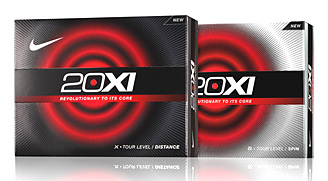 As
always, this
is an informational report based on personal impressions and
performance.
As
always, this
is an informational report based on personal impressions and
performance.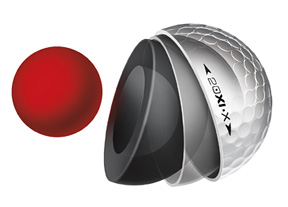 In
golf terms, this means a higher MOI enables a ball to
resist spinning at impact. And since the formula for
distance off the driver is Lower Spin with Higher Launch
Angle, Nike is on to something
special with this new golf ball.
In
golf terms, this means a higher MOI enables a ball to
resist spinning at impact. And since the formula for
distance off the driver is Lower Spin with Higher Launch
Angle, Nike is on to something
special with this new golf ball.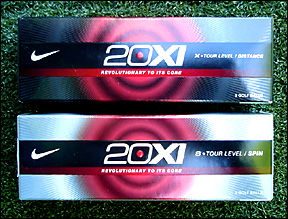 The
balls are available in 2 models, the 20XI-X and the 20XI-S (My
test ball sleeves are seen on the right).
The
balls are available in 2 models, the 20XI-X and the 20XI-S (My
test ball sleeves are seen on the right).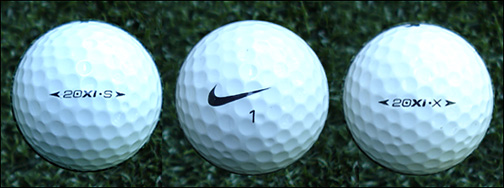
 The
test days were not particularly windy so the full effects of
the wind properties were not relevant. But this is a low spinning
ball off the tee by design so that will be a real feature
of this ball. I would expect little or no ballooning so it could
be a nice
wind
ball for a lot of you reading this report.
The
test days were not particularly windy so the full effects of
the wind properties were not relevant. But this is a low spinning
ball off the tee by design so that will be a real feature
of this ball. I would expect little or no ballooning so it could
be a nice
wind
ball for a lot of you reading this report. 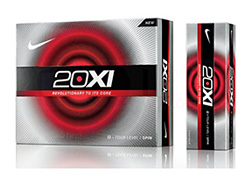 I'll
also mention that Nike states that these balls offer "Tour-level
performance for 90+ mph swing speeds".
Although the ball's best qualities seem to emerge with
above average swing speeds, that should not deter golfers with
lower
swing
speeds
from giving
them a test as every golfer's launch conditions vary.
I'll
also mention that Nike states that these balls offer "Tour-level
performance for 90+ mph swing speeds".
Although the ball's best qualities seem to emerge with
above average swing speeds, that should not deter golfers with
lower
swing
speeds
from giving
them a test as every golfer's launch conditions vary. 